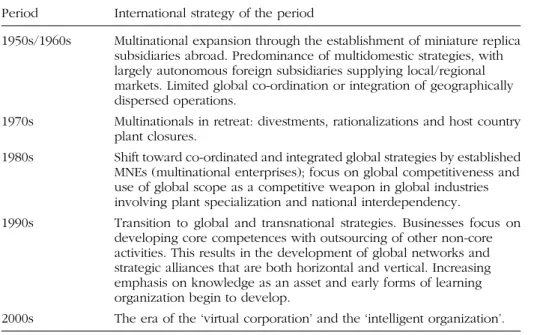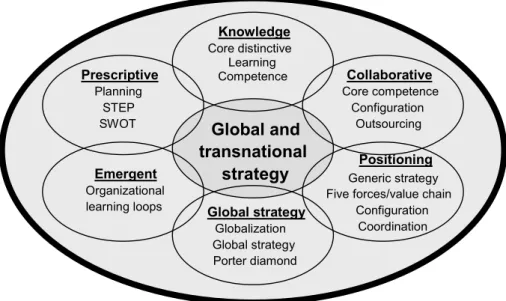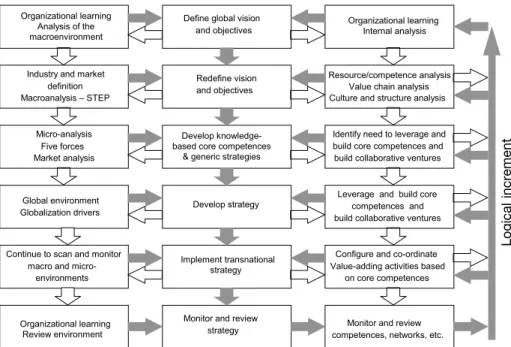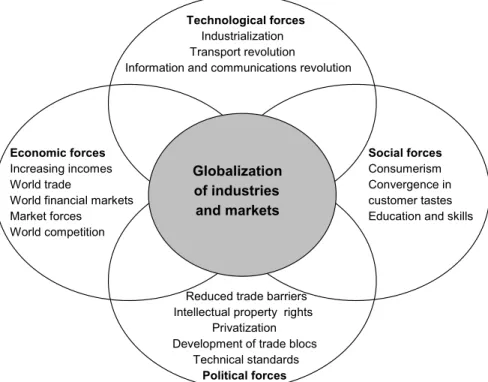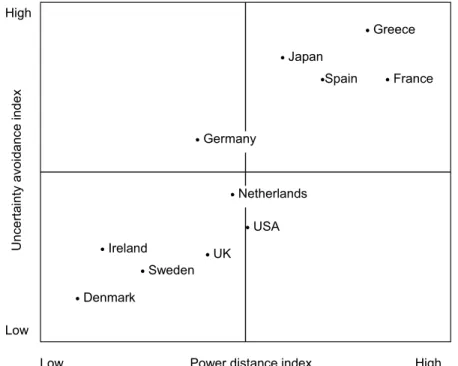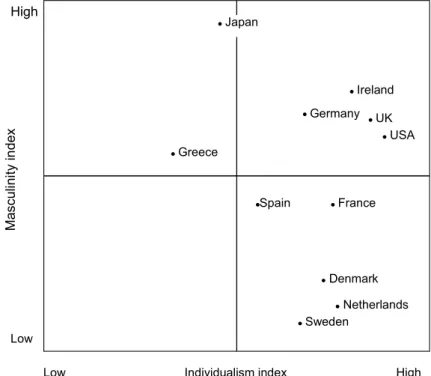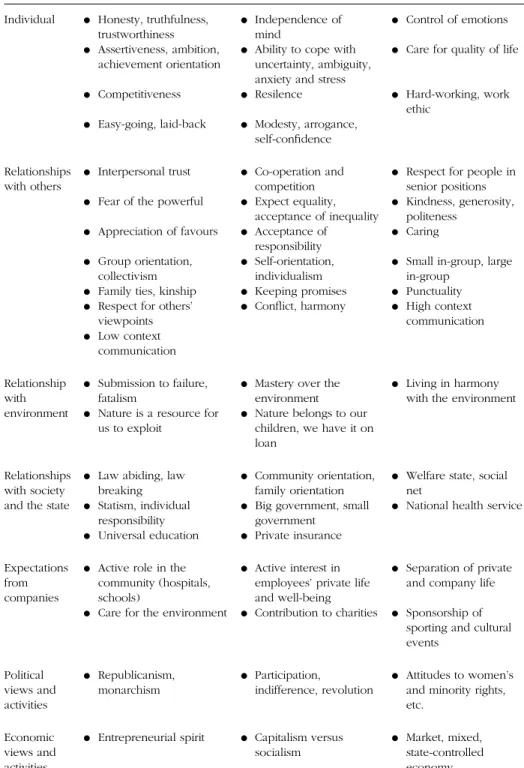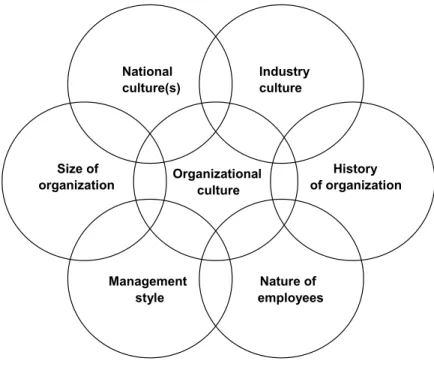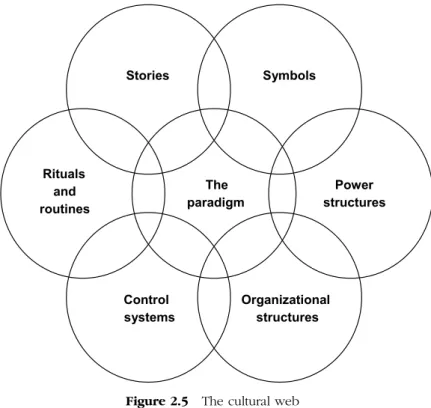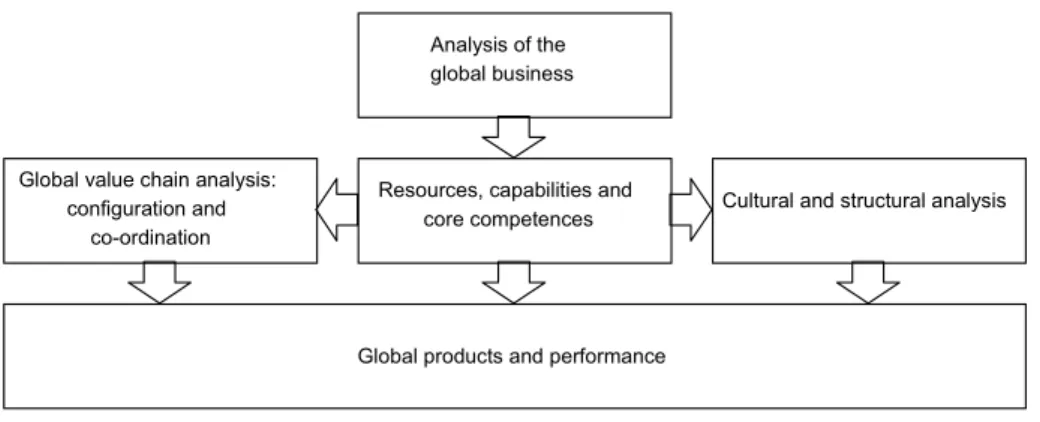Transnational Business:
Strategy and Management
Second Edition
Transnational Business:
Strategy and Management
Second Edition
George Stonehouse Northumbria University
David Campbell
University of Newcastle-upon-Tyne Jim Hamill
University of Strathclyde Tony Purdie Northumbria University
Telephone (þ44) 1243 779777
Email (for orders and customer service enquiries): [email protected] Visit our Home Page on www.wileyeurope.com or www.wiley.com
All Rights Reserved. No part of this publication may be reproduced, stored in a retrieval system or transmitted in any form or by any means, electronic, mechanical, photocopying, recording, scanning or otherwise, except under the terms of the Copyright, Designs and Patents Act 1988 or under the terms of a licence issued by the Copyright Licensing Agency Ltd, 90 Tottenham Court Road, London W1T 4LP, UK, without the permission in writing of the Publisher. Requests to the Publisher should be addressed to the Permissions Department, John Wiley & Sons Ltd, The Atrium, Southern Gate, Chichester, West Sussex PO19 8SQ, England, or emailed to [email protected], or faxed to (þ44) 1243 770620.
This publication is designed to provide accurate and authoritative information in regard to the subject matter covered. It is sold on the understanding that the Publisher is not engaged in rendering professional services. If professional advice or other expert assistance is required, the services of a competent professional should be sought.
Other Wiley Editorial Offices
John Wiley & Sons Inc., 111 River Street, Hoboken, NJ 07030, USA Jossey-Bass, 989 Market Street, San Francisco, CA 94103-1741, USA Wiley-VCH Verlag GmbH, Boschstr. 12, D-69469 Weinheim, Germany
John Wiley & Sons Australia Ltd, 33 Park Road, Milton, Queensland 4064, Australia
John Wiley & Sons (Asia) Pte Ltd, 2 Clementi Loop #02-01, Jin Xing Distripark, Singapore 129809 John Wiley & Sons Canada Ltd, 22 Worcester Road, Etobicoke, Ontario, Canada M9W1L1 Wiley also publishes its books in a variety of electronic formats. Some content that appears in print may not be available in electronic books.
Library of Congress Cataloging-in-Publication Data
Global and transnational business : strategy and management / George Stonehouse. . .[et al.]. – 2nd ed.
p. cm.
Includes bibliographical references and index.
ISBN 0-470-85126-0 (Paper : alk. paper)
1. International business enterprises – Management. 2. Strategic planning.
3. Marketing – Management. 4. Competition, International.
I. Stonehouse, George.
HD62.4 .G528 2004
658.40012 – dc22 2003025487
British Library Cataloguing in Publication Data
A catalogue record for this book is available from the British Library ISBN 0-470-85126-0
Project management by Originator, Gt Yarmouth, Norfolk (typeset in 11/14pt Garamond) Printed and bound in Great Britain by TJ International, Padstow, Cornwall
This book is printed on acid-free paper responsibly manufactured from sustainable forestry in which at least two trees are planted for each one used for paper production.
Preface to the second edition xix
Acknowledgements xxi
PART I 1
1 Strategic and Management Issues in Global and
Transnational Business 3
Learning objectives 3
Global and transnational business – an introduction 3
Some important definitions 3
Box Definitions of globalization 5
Box GATT and the WTO 6
Box Globalization – is it a blessing or a curse? 8
Global and transnational strategy 16
Structure of the book 16
Box Increasing global co-ordination in Philips Electronics 18
Global and transnational strategies and management – the issues 19
A framework for global and transnational strategic management 20
The controversies in strategic management 20
The prescriptive or deliberate approach to strategy 22
The emergent or learning approach to strategy 23
The competitive positioning approach to strategy 23
The resource, competence and capability approach to strategy 24
The knowledge-based approach to strategy 26
The approach to global strategy in this book 26 Assumption 1 Competitive advantage arises from new and superior
knowledge 27
Assumption 2 Organizational learning and knowledge management are vital to creating and sustaining competitive advantage 27 Assumption 3 Strategy is both planned and emergent 27 Assumption 4 Competitive advantage results from both internal
knowledge-based core competence development and from changing conditions in the business environment 28 Assumption 5 It is important to distinguish between industries and markets 29
Assumption 6 Competitive advantage results from both competitive and
collaborative behaviour 29
A summary of the frameworks 29
The global and transnational strategic management process 29
The management process matrix 29
The major elements in the process matrix 30
Conclusion 33
Review and discussion questions 33
References and further reading 34
PART II 37
2 From National Culture to Global Vision 39
Learning objectives 39
Introduction 39
The concept of globalization 40
Industries and markets 40
Causes of market and industry globalization 42
Overview 42
Technological forces 43
Social forces 44
Political and legal forces 45
Economic forces 45
The extent of globalization 46
Globalization and environmental turbulence 47
The example of the South Korean economy 47
Box Tariffs and quotas 47
Currents and cross currents 48
Global mission, objectives and strategy 49
Strategy, purpose and objectives 49
Global vision 50
Vision, philosophy and global strategy 50
Box Nokia’s global vision 51
Culture and global business 52
Levels of culture 52
Box EuroDisney – a European or American cultural identity? 54
Characteristics of culture 55
Hofstede’s cultural dimensions framework 56
Elements of Hofstede’s framework 56
Power distance 56
Uncertainty avoidance 57
Individualism/collectivism 57
Masculinity/femininity 57
Long-term orientation 58
Trompenaars’ dimensions of culture framework 59
Elements of Trompenaars’ framework 59
Relationships with people 60
Time 61
Relating to nature 61
Tayeb – major cultural characteristics observed in various nations 62
The importance and determinants of culture in transnational
business 62
The importance of culture 62
Box Culture and the success of mergers in the automobile industry 64
Organizational culture 65
Determinants of organizational culture 66
Analysing organizational culture – the cultural web 66 Box Sources of culture – an example of the influences on a country’s
culture 69
Review and discussion questions 70
References and further reading 70
Web links 72
3 Analysis of the Global Business 73
Learning objectives 73
Introduction 73
Analysis of the global organization 74
Internal analysis 74
Competences, resources and capabilities 74
Understanding global competences 74
Definitions of resources, capabilities and competences 75
Resources 76
General competences/capabilities 77
Core competences/distinctive capabilities 77
Global value chain analysis 80
Organizations as systems 80
The value chain 80
Primary activities 82
Support activities 83
Using the value chain framework 83
The value system 84
Co-ordinating activities and linkages 85
The ‘global’ value chain 86
A more complex value chain 86
Configuration 86
Co-ordination 87
Global organizational culture and structure 87
The importance of culture and structure 87
Structure 88
Box BP Amoco and global structure 89
Culture 90
Products, performance and portfolio analysis 91
The concept of portfolio 91
The BCG matrix 92
Using the BCG matrix 93
Limitations of the BCG matrix 94
Box BAT in the 1970s and 1980s – managing an international portfolio 95
Global products and services 97
Performance analysis 98
Benchmarking 98
Outside in or inside out? 99
‘Outside in’ strategy 99
‘Inside out’ strategy 100
The two approaches and internal analysis 100
Review and discussion questions 100
References and further reading 101
4 Analysis of the Competitive Environment 103
Learning objectives 103
Introduction 103
The nature of the business environment 104
The importance of environmental analysis 104
The macroenvironment 105
The microenvironment 105
Industries and markets 106
Identifying industries and markets 106
The industry 106
The market 107
The importance of the distinction between industry and market 108
Globalization of industries and markets 109
Yip’s globalization drivers 109
The four categories of drivers 109
Market globalization drivers 110
Cost globalization drivers 112
Government globalization drivers 114
Competitive globalization drivers 115
A summary of the drivers 116
Box The influence of government globalization drivers in the airline
industry 116
Industry analysis 118
Porter’s five-forces framework 118
Force 1: the threat of new entrants 120
Force 2: the threat of substitute products 120
Force 3: the bargaining power of buyers (customers) 121
Force 4: the bargaining power of suppliers 121
Force 5: the rivalry among existing competitors in the industry 122
Use of the five-forces framework 122
Globalization drivers and the five forces 123
Synthesizing the two frameworks 123
Box Ulcer treatments and the international development of Glaxo 123
Market analysis 125
Market identification 125
Customers and their needs 126
Strategic group and competitor analysis 128
What are strategic groups? 128
Box Globalization trends in the pharmaceuticals industry 129
A resource-based approach to environmental analysis 131
Limitations of traditional frameworks 131
Understanding the framework 132
Critical success factors (CSFs) and core competences 134
What are CSFs 134
Review and discussion questions 135
References and further reading 135
5 Analysis of the Global Macroenvironment 139
Learning objectives 139
Introduction 139
Change in the business environment 140
The nature of environmental change 140
Change and prescriptive strategy 141
The macroenvironment 142
STEP analysis 142
Global and national macroenvironments 144
The relationship between global and national macroenvironments 144
The role of national circumstances in international business 145
Determinants of national competitive advantage 145
Box Prudential: factor conditions in Reading, UK and Bombay, India 147
Porter’s Diamond 148
The analytical process 148
Stages in the process 148
Information gathering 149
Information processing 149
Knowledge generation 150
Summary – analysis of the global macroenvironment 151 The links between the micro and macroenvironments 151
Review of the key stages 152
Discussion and review questions 153
References and further reading 153
PART III 155
6 Global and Transnational Strategy 157
Learning objectives 157
Introduction 157
Transnational strategies and global competitiveness 158
Sustainability and competitive advantage 158
Transnational, global and international business strategies 160
Strategies – the choice 161
Competitive positioning 161
Knowledge and competence-based strategy 161
Global strategy 162
Knowledge and competence-based strategy 163
The emphasis on the organization itself 163
The components of core competences 163
Core competences and distinctive capabilities 165
Knowledge, core competences and global competitive advantage 166
Knowledge 167
Knowledge creation and management 168
Box Sharp Corporation – a knowledge-centric organization 169
Organizational learning 169
Knowledge creation and management in transnationals 170
Competence building and leveraging 170
Summary of knowledge and competence-based strategy 172 Alternative approaches to resource-based strategy 172
Distinctive capabilities 173
Box Manchester United and superior performance 173
Competitive positioning – Porter’s generic strategies 175
The generic strategy framework 175
Cost leadership strategy 176
Differentiation strategy 177
Focus strategy 177
Hybrid strategies 178
Knowledge, core competence and generic strategy – a synthesis 179
Drawing the threads together 179
Global and transnational strategy 181 Porter’s model of global strategy – the value system 182
Configuration 182
Co-ordination 183
Integration and responsiveness 184
Pressures for and against increased global co-ordination 185
Regional strategies 186
Total global strategy 187
Development of total global strategy 187
Transnational organizations 189
Global and localized elements of transnational strategy 190 Box McDonald’s Inc. – an example of transnational strategy 192
Discussion and review questions 193
References and further reading 194
7 Global and Transnational Market-servicing Strategies 197
Learning objectives 197
Introduction 197
Alternative foreign market-servicing strategies 198
What is market servicing? 198
Market-servicing options 199
Box International expansion through franchising – Holiday Inn 201
A summary of the modes of entry 207
Selection of mode of entry 209
Choosing the most appropriate mode of entry 209
Criteria for choosing mode of entry 210
Global market-servicing strategies 210
Literature summary 210
Three key variables 212
Collaborative arrangements 212
Collaboration rather than competition 212
The nature and rationale of collaboration 214
Horizonal and vertical collaboration 215
Alliances 216
Summary – advantages of collaborative arrangements as modes of entry 217
Appendix 7.1 Some additional notes on foreign
market-servicing strategies 217
Exporting 217
Contractual agreements 218
Foreign direct investment 219
Box Toyota – FDI greenfield development in the UK 219 Box Philip Morris – foreign acquisitions in the former communist states of
central and eastern Europe 220
Review and discussion questions 221
References and further reading 221
8 Global Production and Logistics Management 227
Learning objectives 227
Introduction 227
Production strategy and competitive advantage 228
The critical success factors in operations 228
Global production strategies 229
The ‘big’ decisions in production strategy 229
Plant roles and inter-plant relationships 230
Research in global productions strategy 231
Doz – opportunities from relaxations in trade restrictions 231
Starr’s network 233
Dicken and international value adding 233
Dicken’s four production strategies 234
Plant location decision making 236
Decision criteria 236
The most frequently used criteria 238
The location decision 239
Procurement and transnational business 240
Procurement policy 240
Types of purchasing policy 241
Global logistics 242
The ‘flow’ of materials 242
Logistics and strategy 243
Managing logistics 244
Discussion and review questions 244
References and further reading 244
PART IV 247
9 Global Leadership and Strategic Human Resource
Management 249
Learning objectives 249
Introduction 249
Leadership and management in transnationals 250
Definitions 250
The nature of leadership 251
Box GE – the new leadership paradigm 253
Leadership and cultural issues 254
Box Body Shop: embracing a new management ‘ethos’ 254
Leading and managing cultural diversity in transnational organizations 255
Shaping culture in transnational organizations 256
Strategic human resource management 257
The importance of human resources 257
Features of HR strategy 258
HR strategy, core competences and organizational learning 259 Integration of HRM with corporate strategy and functional strategies 259
Criticisms of the concept of strategic HRM 262
European and American approaches to HRM 262
A transnational model of HRM 263
Porter’s global strategy and HR strategy 264
Congruence between HR and corporate strategy 264
Review and discussion questions 266
References and further reading 266
10 Global Technology Management 269
Learning objectives 269
Introduction 269
Technology and strategy 270
The impact of technology on strategy 270
Technology as a strategic asset 271
Defining technology 271
Technology and products 272
Technology and production 273
Patterns of technological innovation 274
Differences between technology and other assets 275
Technology and global competitiveness 276
Technology strategy 277
The components of a technology strategy 277
Technology audit 277
Sourcing new technology 278
Exploiting new technology 281
Protecting the competitive advantage 283
Box When patents expire 284
Comparisons of transnational technological performance 285
Comparing US and Japanese performance 285
Learning good practice 287
Information and communication technologies 287
The effects of ICT 287
Developments in ICT 288
ICT and transnational strategy 290
Configuring ICT for transnational business 291
Discussion and review questions 292
References and further reading 292
11 Global and Transnational Marketing Management 297
Leearning objectives 297
Introduction 297
The role of marketing in global and transnational strategy 298
Marketing and strategy 298
Marketing and competitive advantage 300
Ohmae’s (1989) view of marketing 300
Globalization of markets and marketing research 301
Global marketing strategies 302
Different perspectives 302
Douglas and Craig’s (1989) typology 303
Leontiades’ (1986) perspective 304
Four stages in a global marketing strategy 305
Global market segmentation and positioning strategies 308
Segmentation bases 308
Market positioning 309
Global marketing management 310
Marketing mix strategy 310
Box McDonald’s – globally homogeneous? 311
Global products 313
The importance of product decisions 313
Decisions on product strategy 314
Global branding 315
Global pricing 318
Pricing decisions 318
Transfer pricing 323
Pricing decisions – a summary 324
Global promotion 324
Marketing communications 324
Standardization of global promotion 325
Organization and control of promotions 325
The management of global promotional campaigns 329
Choosing an advertising agency 330
ICT and global marketing 331
Box Axis Communications Inc. – the Internet and global marketing 333
Review and discussion questions 334
References and further reading 335
12 Global Financial Management 339
Learning objectives 339
Introduction 339
Finance management and the global enterprise 340
The key issues in international financing 340 Box Foreign exchange risk management at British Airways (BA) 341
Centralization versus decentralization of the finance function 343
Different approaches to decentralization 343
Decision area 1: financing foreign operations 344
The options 344
Equity capital 346
Debt (or loan) capital 346
Decision area 2: resource allocation and capital budgeting 348 Uncertainties constraining the certainty of choice 348
Political risk 349
Assessing and forecasting political risk 349
Dealing with political risk 350
Decision area 3: operational policies 351
Working capital and cash flow management 351
Foreign exchange exposure 353
Reducing exposure 354
Decision area 4: remittance strategy 355
Types of funds transfer 355
Problems with transferring funds 355
Blocked funds 356
Discussion and review questions 358
References and further reading 358
13 Organizational Structure and Control in Global and
Transnational Business 361
Learning objectives 361
Introduction 361
Some essentials of organizational structure 362
Key variables 362
‘Height’ and ‘width’ of structures 362
Hierarchical configuration of structures 364
Determinants of organizational structure 364
Mintzberg’s determinants 364
The contingency approach 365
The configuration approach to organizational design 368
Types of international organizational structure 369
International structures 370
Global structures 371
The development of global and transnational matrix structures 374
Stimuli to matrix development 374
Global matrix structures 374
The development of the transnational organizational structure 376
National influences on structural form 376
‘Anatomy’ and ‘physiology’ 377
Features of transnational structures 378
The transnational model 379
Decision making and control in international business 382
Decentralization and control 382
Empirical studies 383
Evaluating performance 384
Global and transnational strategies, organization and control 385 The influence of strategy on structure and control systems 385
Discussion and review questions 386
References and further reading 387
14 Managing Global Mergers, Acquisitions
and Alliances 391
Learning objectives 391
Introduction 391
An overview of integrations and alliances 392
Perspectives on external growth 392
Types of integrations and alliances 393
Transnational mergers and acquisitions 395
The key definitions 395
Motivations for transnational M&As 396
Box Hoechst and Rhoˆne-Poulenc merge to form Aventis, a new global
leader in life sciences 397
Problems with integration 398
Successful M&As 399
Box DaimlerChrysler 402
Collaborative ventures and strategic alliances 403 What are collaborative ventures and strategic alliances? 403
Motivations for forming strategic alliances 405
Types of strategic alliance and collaborative venture 405
Directions of alliances 405
The extent and timescale of collaboration 407
Choosing the most appropriate type of alliance 408
Box Collaborative strategy in the international airline industry 409
Successful alliances 411
The strategic management of networks and alliances 412
The concept of the ‘focal’ business 412
Discussion and review questions 413
References and further reading 414
15 Global Business – Present and Future Trends 419
Learning objectives 419
Introduction 419
The global business environment – limits of globalization 420
The real state of homogenization 420
Physioeconomic theory 420
Challenging the presuppositions 421
A global approach to strategy and management? 422
Global competitive advantage in the future 423 Knowledge-based strategy: the intelligent organization 424
The ‘virtual’ corporation 427
Discussion and review questions 428
References and further reading 429
Appendix 1 McDonald’s and Its International Expansion 431
A brief history 431
McDonald’s and franchising 434
International growth 435
Appendix 2 Nike Inc. 439
Company development 439
The Nike product concept 440
Vertical linkages and outsourcing 441
Promotions and endorsements 443
Markets and structure 444
Changes in the 1990s 445
Nike at the end of the 1990s 446
References and further reading 447
Index 449
E D I T I O N
International business is one of the most fertile areas of academic research in British and American university business schools, and the number of research articles and textbooks produced in the area in recent years is testimony to this intellectual fecundity. The eclecticism of the field, drawing as it does on studies in general strategy, politics, economics and philosophy presents another set of challenges to authors such as ourselves – what to include for completeness and what to leave out or excise in the interests of accessibility and brevity. We acknowledge this tension and hope we have pitched this second edition about right.
Two issues distinguish this edition from the first: an increased emphasis on knowledge as a source of transnational competitive advantage and a modification to the way in which case materials are used.
We felt it important in this edition to reflect the debate in the strategy literature on the sources of competitive advantage to international busi- nesses. In explaining competitive advantage from the perspective of knowledge management and organization learning, we have dismissed neither the competitive positioning school nor the core competence/
resource-based perspective. We view the understanding of competitive advantage from a knowledge-based perspective as an enrichment of both of the previous explanations and seek to explain this synergy at several points in the text as the context requires. This has meant substantial revisions to Chapters 1, 2, 6 and 9.
The second change made for the second edition is in the way in which case materials are presented. The first edition contained a suite of six ‘long’
cases at the end of the text. After feedback from our adopters and some discussion, including with the publisher, we decided to change the focus of the cases. We have reduced the number of cases at the conclusion of the book to two (retaining the Nike case and adding a new one on McDonald’s) and added several shorter ones as ‘in-chapter’ examples. We hope this new format provides for an effective learning experience.
P A R T I
M A N A G E M E N T I S S U E S I N
G L O B A L A N D
T R A N S N A T I O N A L B U S I N E S S 1
Learning objectives
After studying this chapter students should be able to:
. define the key terms used in the study of international business;
. describe the changes in international business behaviour in the second half of the 20th and early 21st century;
. explain the causes, nature and problems of globalization;
. describe some of the key issues in global and transnational busi- ness management;
. define and distinguish between the ‘big controversies’ in strategic management in relation to global business;
. explain the management processes involved in successful global and transnational business management.
Global and transnational business – an introduction
Some important definitions
Globalization is pehaps the single most important force at work in con- temporary society, business, management and economics. For this reason, it is strategic management in a global context that forms the central theme of this book. Globalization is a complex phenomenon, and this chapter explores its causes, nature, effects and implications for managers in modern business organizations. Alongside the exploration of globalization,
this chapter examines recent developments in strategic management and identifies their impact on transnational management, setting out the analy- tical frameworks which will form the core of the subsequent chapters.
It is useful to begin by clarifying some of the terminology used in the literature of international business. The termsinternational,multinational, transnationalandglobalbusiness are often used interchangeably. This can be a cause of serious confusion, so it is important to define and distinguish between the terms. A spectrum of international business activity can be identified depending on the nature and extent of a business’s involvement in international markets and the degree of co-ordination and integration of geographically dispersed operations. The importance of making this distinction lies in the fact that the strategic and management issues facing an organization will vary considerably depending on the breadth of its international presence.
International, multinational, global and transnational business
The term international business simply implies that an organization is operating in more than one country or, to put this another way, organiza- tions from different countries are trading across their national boundaries.
In this sense it is a generic term. A business that is multinational is one conducting international business and operating in several countries; but, in addition, Bartlett and Ghoshal (1989) suggested the term implies some decentralization of strategy and management decision making to overseas subsidiaries, with little co-ordination of activities and subsidiaries across national boundaries. In other words subsidiaries operating in different countries are allowed considerable autonomy in terms of their strategies, which are largely determined by local conditions. In contrast, a global business is one conducting its activities in a large range of countries across the world with a single strategy that is highly co-ordinated and integrated throughout the world. Company strategy is determined centrally and subsidiaries have little autonomy in their operations. Finally, the term transnational business describes the situation when an organization conducts its activities across national boundaries, with varying degrees of co-ordination, integration and local differentiation of strategy and opera- tions, depending on market and business conditions.
Globalization
One of the most used yet complex terms in international business isglobal- ization. The word is used to describe a range of related but distinct, socio- logical, economic, political and business phenomena. In general terms,
globalization refers to the development of global or worldwide business activities, competition and markets and the increasing global interdepen- dence of national economies.
In economic terms, globalization refers to the increasing interdependence between national economies and markets. From a sociological perspective, it describes an increasing degree of cultural interaction and convergence between the countries of the world. From the standpoint of business, globalization describes the increasingly global nature of markets, the tendency for transnational businesses to configure their business activities on a worldwide basis, and to co-ordinate and integrate their strategies and operations across national boundaries.
Definitions of globalization
Globalization of economies – increasing interdependence between national economies throughout the world.
Globalization of markets – increasing homogenization of consumer tastes and product preferences in certain markets, as evidenced by the popularity of global brands in certain markets, like Armani, Hugo Boss and Calvin Klein in fashion clothing, McDonald’s, Burger King and Pizza Hut for fast food, and Coca-Cola and Pepsi-Cola for soft drinks.
Globalization of industries – the increasing globalization of the productive process, with firms choosing to concentrate or disperse value-adding activities around the world according to the locational advantages to be obtained.
Globalization of strategy – the extent to which an international business configures and co-ordinates its strategy globally. A global strategy will normally include a global brand name and products, presence in major markets throughout the world, productive activities located so as to gain maximum advantage, and co-ordination of strategy and activities throughout the world.
Although the origins of globalization can be traced back to the early history of international business, its rapid acceleration in the 19th and 20th centuries can be attributed to relatively recent developments in:
. manufacturing technology, which began during the industrial revolu- tion, making mass production possible;
. transportation technology, like railways, motor transport, steam shipping and aeroplanes, allowing the movement of people, materials and fin- ished products from country to country and continent to continent more quickly and cheaply;
. information and communications technology, like the telephone, com- puters, the Internet, satellite television, which have together contributed to both the globalization of markets and the global co-ordination of worldwide business activities;
. trade liberalization, through GATT (the General Agreement on Tariffs and Trade) and its successor, the WTO (the World Trade Organization), which have reduced tariff and other barriers to trade between countries;
. rising real term incomes, which have contributed to an increase in demand for products and services worldwide.
GATT and the WTO
The most prominent international trade agreements are the General Agreement on Tariffs and Trade (GATT) and its successor, the World Trade Organization (WTO). The GATT agreement began life as the Havana Charter 1948 when 23 countries acted as signatories to what they hoped would become an international trading organization (ITO). As negotiations progressed, it became clear that such a world- wide trading block was too ambitious and so a ‘general agreement’ was arrived at. The main points of the agreement were as follows:
1
tariffs should not be increased above current levels;1
quotas should be reduced and eventually abolished;1
each signatory was a ‘most favoured nation’ (this meant that trading privileges extended by one member nation to another must be widened to include all of the others);1
the general agreement recognized that other trading blocks may exist, such as the EU and NAFTA (North American Free Trade Area), but these were encouraged to be outward-looking rather than insular as far as trading restrictions were concerned.The WTO has evolved over the years through the staging of several
‘rounds’ of lengthy and complicated negotiation. The number of countries subscribing to the WTO has grown as the various rounds have progressed. With over 100 members, the WTO now accounts for about 80% of international trade. Overall, the WTO has succeeded
in generally reducing import tariffs and significantly cutting down on quotas. Recent rounds have focused on attempting to reduce the stark variations in prosperity between wealthy and poorer countries – the
‘north–south dialogue’.
Globalization and business
From the perspective of business, interest in globalization centres on two major facets: the globalization of markets and the globalization of produc- tion and the supply chain. Levitt’s seminal work of 1983, ‘The globalization of markets’ (Levitt, 1983), suggested that technological change, social, polit- ical and economic developments have, in recent decades, driven the world toward a ‘global village’ or ‘converging commonality’ – a homogenized, unified global market in terms of consumer tastes and product preferences.
For Levitt, the main beneficiaries of this convergence would be global organizations producing globally standardized products in order to achieve world economies of scale. Such global businesses are able (because of scale economies) to undercut the prices of more nationally orientated competitors. Levitt concluded that a global strategy must be based on standardization of product, branding and advertising.
While there is strong evidence that many markets are becoming increas- ingly global in certain respects, an approach to strategy that concentrates almost exclusively on standardization and costs represents an oversimpli- fication of the situation. The global environment is becoming increasingly complex and requires more sophisticated approaches to strategy. There are important variations in consumer needs regionally and locally, as well as globally. At the same time as markets become more global, consumers are becoming more sophisticated, demanding products (goods and services) that are differentiated rather than standardized. Thus, although the market may be essentially global, the sophistication of consumers’ needs and wants will dictate that strategy must be flexible and responsive, rather than rigidly standardized.
A further complexity is that globalization is not confined simply to con- sumer markets but also relates to the global scope of all of an organization’s business operations and its ability to compete on a global scale (Yip, 1992).
Yip used the term ‘total global strategy’ to describe an approach to strategy that embraces the worldwide scope of an organization’s activities, a view that the whole world is a potential market. Yip, however, recognized the need to adapt aspects of strategy where local conditions dictate.
Porter (1990) focused on the globalization of an organization’s value- adding activities. Globalization has given business the opportunity to con- figure its activities so as to take account of locational and other advantages arising from differences in resources, skills and economic conditions in different parts of the world. By configuring its activities to take advantage of these differences and by co-ordinating its global activities effectively, an organization can gain global competitive advantage. Bartlett and Ghoshal (1989) used the word transnational to describe the configuration, co- ordination and control of global business activities across national boundaries in the pursuit of global competitiveness, at the same time as encompassing local adaptation and differentiation of organizational strategy and structures. Such an approach to business allows an organization to take advantage of both global and local advantages and opportunities.
Both markets and the ways in which international businesses configure and co-ordinate their activities are becoming increasingly global in scope and transnational in nature. It is the process of developing global and transnational strategies, and the management and co-ordination of world- wide operations that provide the main focus to this text.
It should be obvious that definitions of the term globalization that are either overly prescriptive or vague are not particularly useful. Few markets and industries are fully global although many display global characteristics (Yip, 1992). A global strategy of complete world standardization is therefore unlikely to be successful and, as a result, very few (if any) organizations adopt such strategies. Otherwise ‘global’ corporations like McDonald’s and Coca-Cola make minor adjustments to their strategies as national circum- stances demand. Using the term ‘globalization’ to describe the strategy of any company expanding abroad is too wide in scope since it would en- compass all businesses with any interests overseas, and clearly not all such organizations are global.
Globalization N is it a blessing or a curse?
Globalization has become one of the most contentious political and economic issues of modern times. It is the subject of debate, demon- strations and even violence. So what is it that gives rise to such passions and are there any answers to the problems?
There is no single form of globalization; rather there are many.
Globalization of markets is the development of products satisfying customer needs that are common throughout the world (‘market’ in
this context refers to the demand side of an economic system of ex- change). This may be the need for fast food, soft drinks, films, popular music, sport, fashion clothing, fragrances, computers, consumer elec- tronics and so on. In these circumstances consumer needs throughout the world appear to have grown more similar, perhaps based on cultural convergence (i.e., national cultures growing more similar to each other). The advantage to consumers is that their choice of products has widened and that prices have fallen. The advantage to producers is that they are able to earn much higher revenues, which in turn finance research and development of new products, and that they are able to achieve economies of scale, which then reduce unit costs of production. Sony, the Japanese electronic giant, is able to introduce a constant stream of new and improved products, financing the devel- opment out of global sales revenues and keeping prices low on the basis of the huge economies of scale obtained.
The second form of globalization relates to the way in which firms organize their value-adding activities on a worldwide basis, according to availability of resources, cost levels, skills, quality and so on. The firms benefit from much lower unit cost levels and often higher quality manufacturing. Consumers benefit from lower prices and increased choice, together with better quality. Designer clothing, including labels like Ralph Lauren, Calvin Klein, Armani and Yves St Laurent, is produced in the Far East and thus made affordable to consumers because of low production costs (because labour costs are often cheaper in the Far East than in the West).
Both the globalization of markets and production have led to the development of huge transnational organizations or global companies whose revenues exceed the national incomes of many medium-sized countries. Such organizations produce and sell throughout the world.
Organizations like General Electric, Microsoft, Procter and Gamble, Unilever, Sony, Ford, General Motors, Toyota and their activities span the globe.
At the same time technological developments like the Internet and air travel have considerably increased the interdependence between the countries of the world. Increased travel and improved communica- tions have increased awareness of ethnic products and of political, social and economic events and changes. Satellite television, films and package holidays have all increased consumers’ awareness of and demands for foreign products.
The blessings
Many people argue that these types of globalization have brought many benefits. Consumers have access to a much wider range of prod- ucts, which are constantly being updated, and at relatively low prices.
Increased global trade has made people wealthier and allowed them to lead more diverse lifestyles. Companies benefit from access to global markets and low cost production in developing countries. Developing countries like Thailand, Vietnam and Cambodia, it is argued, benefit from increased levels of employment and increasing wage levels.
Transnationals like Nike pay wages well above the local average but well below those in the USA.
Globalization is not entirely a new phenomenon, however. Trade between nations goes back centuries and even millennia, but the extent of globalization and its rate of increase have been most marked in the years following World War II (1939–45). There are many reasons that may account for this change. Rising real term (i.e., after inflation) incomes and living standards have led to a dramatic increase in demand for consumer products while international travel and communications have introduced consumers to products from other countries. Western democracies have played an important role by placing increasing emphasis on the market economy as a vehicle for economic growth and by building and strengthening international ties as a way of fostering trade and good international relations.
The developing of international ties, increasing travel and the devel- opment of the Internet have diminished the importance of national borders and brought about greater interdependence and fusing of indi- vidual national markets. At the same time the reduction in protectionist barriers, resulting from the work of organizations like GATT and its successor, the WTO, has stimulated free movement of products and capital and paved the way for the development of transnational organizations with centres throughout the world.
So, globalization has been welcomed by consumers and by capital- ists who believe in international free trade between nations as a matter of principle. For consumers, international trade has increased com- petition, driven down prices, given greater choice in High Street stores, and these factors have, in turn, resulted in greater spending, rising living standards and increased international travel. In addition,
sympathizers with globalization say it has increased information flows between countries, assisted cross-cultural understanding, promoted democracy and furthered world peace. The fall of communism in Eastern Europe and the absence of a major war in Western Europe since 1945 are all attributed, at least in part, to increased international trade and understanding between the nations of the world.
The curses
In the face of all these economic, social and political benefits, it may be difficult to understand why several anti-globalization demonstrations have taken place. What is it that arouses such anti-globalization passions? The groups of demonstrators who protested against global- ization in Seattle in November 2000 at the World Trade Organization conference in London, at the G8 meeting in Genoa, and in Prague at the annual meetings of the International Monetary Fund and the World Bank clearly believe that globalization is essentially a harmful phenomenon.
The demonstrators argue that the gains in living standards in the developed countries has been at the expense of the developing coun- tries. While living standards have risen for many as a result of global- ization, more than a billion people live in extreme poverty throughout the world. Globalization has brought no benefits for these people. In fact, the share of the global income of the poorest people in the world fell throughout the 1990s. The already impoverished countries are becoming even poorer. The gap between rich and poor is becoming ever wider. They argue that although transnational organizations may have brought employment to some developing countries, some are accused of employing child labour, condoning inhumane working conditions and paying slave wages among producers in developing countries. In addition to this, what of the underdeveloped countries in Africa that have enjoyed little or no investment by transnationals and whose economies show little or no sign of development?
Even in the developed economies, globalization has been the cause of problems. In developed countries there have been huge job losses among unskilled workers as transnationals shift production to low- wage economies in the developing world. Some small businesses in developed countries are afraid of transnationals, fearing that they may
be forced out of business if they are unable to emulate the economies of scale and low costs of these global juggernauts.
Globalization brings threats to the national cultures and identities of developing and developed countries alike through the spread of satel- lite TV, the development of international media networks and in- creased personal travel. Some traditional customs, industries and languages are disappearing.
Huge transnational companies are seen as a threat to democracy as they have greater economic power than the governments of the devel- oping countries in which they are operating. They may fatally damage the economy of a country by attaching greater importance to share- holder value than to social, cultural and national economic concerns. It is suggested that they threaten human rights through their selfish pursuit of profit.
The transnationals are also accused of damaging the ecological environment in the pursuit of profits. Developing countries contribute little to the world’s pollution problems while the developed countries contribute much. Transnationals may bring the problem to the developing countries as they seek ever increasing levels of low-cost production. Increasing levels of global consumption also threaten the world’s non-renewable resources. Our living standards today may be at the expense of future generations. Our growth in living standards may not be sustainable.
The opposition groups
The protesters who have gathered in Seattle, London, Genoa and Prague to highlight these fundamental issues represent a disparate group of causes, unified only by their opposition to globalization.
They are an unlikely coalition of environmentalists, anti-poverty cam- paigners, trade unionists, anti-capitalist groups and anarchists who tend to view globalization and transnational companies as a major threat to people, the developing countries and the environment. One umbrella group that sought to unite these anti-globalization groups in Prague was the Initiative Against Economic Globalization (INPEG). It provided the campaigning groups with training in demonstration management, making human chains, first aid, tree climbing, street theatre and com- municating with the media. INPEG described itself as ‘a loose coalition of various Czech environmental, human rights and autonomist/
anarchist groups, organizations and individuals who are ready to stand up critically against the summit of the world financial oligarchy.’
The record of these demonstrations is not itself good. They have been marred by violence, death and destruction of property. These acts may only be perpetrated by a small minority of demonstrators, but they feature heavily in the portrayal of the demonstration by the world’s media. The heavy media coverage of these acts of violence tends to cloud the basic issues of social justice, sustainability and ecology that underpin the globalization debate. It is ironic, however, that it is the world’s media, the epitome of globalization itself, that allows the debate to take place across national and continental bound- aries. Perhaps this is indicative of the fact that the global village, predicted by Marshall McLuhan, has already arrived.
Can globalization be managed?
If globalization is a trend that can be traced back far into our history and that is inextricably intertwined with so many people’s lives, can its march be halted? Indeed, is it desirable to halt its march? It is likely that it is impossible to halt the driving forces behind globalization. The vast majority of people throughout the world, especially in developed countries, are addicted to consumerism and actively seek new products at low prices. They may well be concerned about the conditions under which the products are produced, but are unwilling to completely boycott their purchase. Nevertheless, companies like Nike have been forced to monitor and improve the conditions under which the workers producing their products are employed. They have sought to eliminate child labour, raise wage levels and provide social and medical benefits to workers in the factories producing the products as a result of the pressure of public opinion.
People in developing countries lived in poverty before globalization, and it is unlikely that poverty can be meaningfully tackled without the assistance of foreign governments and without investment from trans- nationals. The wages paid by transnationals in developing countries may be well below those paid to workers in developed countries but they are, nevertheless, often well above average wage levels through- out the developing world.
The answer to the problems posed by globalization may therefore not be to try to prevent change, but to seek to ameliorate and eliminate
its harmful consequences. In other words governments, international bodies like the WTO, IMF and World Bank, and transnational busi- nesses must work together to create conditions under which the poten- tial benefits of globalization are realized while its potentially damaging outcomes are eradicated.
Free trade between countries is often presented as necessary for global business. Yet free trade need not mean a complete absence of regulation. The dangers of the monopoly power of developed coun- tries and huge transnationals must be controlled. Developing countries must be assisted in achieving economic prosperity. Free trade need not be unregulated trade. Bodies like the WTO seek to develop rules through which developing countries and their populations are pro- tected. The problem is that developing countries are a majority of the WTO’s members and can dominate its proceedings. This is not surprising when half the least developed countries have no representa- tion at the WTO headquarters in Geneva. The WTO must find mech- anisms for representing the opinions of developing countries and for implementing rules that prevent developed countries and transnational businesses from striking deals that harm the developing world. Further- more, the WTO must set and achieve development targets that reduce poverty, create sustainable development and protect the environment.
The world’s governments have agreed to targets like halving the number of people living in poverty by 2015, universal primary educa- tion in all countries by 2015, gender equality, a reduction of two-thirds in infant mortality rates by 2015, improved primary health care and the implementation of national strategies for sustainable development in all countries by 2005.
The reduction of poverty is not simply a social and moral issue it is also economic and political. Globalization means increasing inter- dependence between nations. If the poorer countries become richer then they become markets for the products and services of transna- tionals. If developing countries have social and political problems then they also affect developed countries. As a consequence it is in the interests of developed countries to assist their development. The uneven spread of the benefits of globalization, as illustrated by the development of East Asian countries compared with the failure to improve the lives of millions of people in rural Africa, remains an issue.
It remains a challenge for the governments of poorer countries to create domestic conditions that attract foreign investment. This means
the elimination of corruption, the development of education, the reg- ulation of working conditions and the provision of primary health care.
These governments cannot achieve these goals on their own and must be assisted by developed countries and by international bodies. There are many causes of poverty, but it is widely accepted that education is an important factor in its reduction. Recent research suggests that investing in primary education, particularly for girls, is the most effec- tive path to economic development and the elimination of poverty.
Education creates a skilled and adaptable workforce that attracts inward investment and rising levels of income. At the present time (2003) it is estimated that worldwide 113 million children of primary school age have never gone to school and a further 150 million drop out before achieving basic literacy and numeracy skills.
Transnational businesses can themselves play a much greater role in reducing poverty and creating sustainable development. They can insist on best practice in relation to child labour, corruption, corporate governance, human rights, health and safety, and the environment, so creating employment, eliminating poverty and improving conditions in poor countries. Many companies have already realized the benefits to their reputations and productivity levels that can be achieved by investing and setting standards in poor countries.
Developed countries might also set a better example in terms of protecting the environment, reducing pollution and preserving natural resources. Developing countries might then, in turn, ensure that their newly emerging industries conform to global environmental agreements (such as the Rio and Kyoto Protocols).
A key way in which developed countries can assist the poorer nations is through aid. Developing countries have already been given huge amounts of aid, but it has often been given unwisely and used equally as badly. Lending governments have often tied aid to contracts for their countries’ products. The governments of developing countries have often not made the best use of the money that they have received. It is generally accepted that aid should be used to create conditions in developing countries which not only help the poor but also attract inward investment that assists in promoting economic growth.
Globalization cannot be prevented but can be managed by govern- ments, international bodies and global businesses to raise living standards for all.
